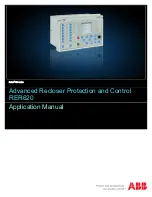
CHAPTER 4: SETPOINTS
PROTECTION
845 TRANSFORMER PROTECTION SYSTEM – INSTRUCTION MANUAL
4–235
Frequency Rate of
Change (81R)
There is one Frequency Rate of Change protection element which can respond to rate of
change of frequency with voltage, current and frequency supervision.
The Rate of Change element may be set as an instantaneous element with no time delay
or as a definite time delayed element. The rate of change element has the programmable
minimum operating voltage and current thresholds to prevent undesired operation under
specific system conditions.
The settings of this function are applied to each source to produce Pickup and Trip flags.
The Frequency Rate of Change Pickup flag is asserted when the calculated frequency rate
of change of the specified source is above the PKP value, the voltage and current are
above the MINIMUM levels, and the frequency is within a certain range. The Frequency
Rate of Change Trip flag is asserted if the element stays picked up for the time defined by
the Pickup time delay. The element instantaneously drops from Pickup without operation, if
the frequency rate of change drops below 96% of the Pickup value, before the time for
operation is reached.
The minimum voltage and current thresholds select the minimum voltage and current
below which the element is blocked.
The minimum and maximum frequencies set the operating frequency range out of which
the element is blocked.
Path
:
Setpoints > Protection > Group 1(6) > Frequency > Frequency Rate of Change 1(X)
FUNCTION
Range: Disabled, Trip, Alarm, Latched Alarm, Configurable
Default: Disabled
The selection of the Trip, Alarm, Latched Alarm, or Configurable setting enables the
element.
When the Trip function is selected and the element operates, output relay #1 “Trip” will
operate but the “ALARM” LED will not turn on.
When the Alarm function is selected and the element operates, the “ALARM” LED will
flash; it will self-reset, when the operating conditions are cleared.
When the Latched Alarm function is selected, and the element operates, the “ALARM”
LED will flash during the TOC operating condition, and will be steadily lit after the
conditions are cleared. The “ALARM” LED can be cleared by issuing a Reset command.
Output relay #1 “Trip” will not operate if the Alarm or Latched Alarm setting is selected.
When the Configurable function is selected, neither the Trip output, nor the ALARM LED
will turn on automatically. They must be configured using their own menus and
FlexLogic operands.
The selected output relays #3 to #7 will operate if the Trip, Latched Alarm, Alarm or
Configurable setting is selected and the element operates
TREND
Range: Decreasing, Increasing, Bi-directional
Default: Decreasing
The setting allows configuring of the element to respond to increasing or decreasing
frequency, or to a frequency change in either direction.
Summary of Contents for 845
Page 10: ...VIII 845 TRANSFORMER PROTECTION SYSTEM INSTRUCTION MANUAL ...
Page 219: ...CHAPTER 4 SETPOINTS SYSTEM 845 TRANSFORMER PROTECTION SYSTEM INSTRUCTION MANUAL 4 91 ...
Page 221: ...CHAPTER 4 SETPOINTS SYSTEM 845 TRANSFORMER PROTECTION SYSTEM INSTRUCTION MANUAL 4 93 ...
Page 222: ...4 94 845 TRANSFORMER PROTECTION SYSTEM INSTRUCTION MANUAL SYSTEM CHAPTER 4 SETPOINTS ...
Page 223: ...CHAPTER 4 SETPOINTS SYSTEM 845 TRANSFORMER PROTECTION SYSTEM INSTRUCTION MANUAL 4 95 ...
Page 224: ...4 96 845 TRANSFORMER PROTECTION SYSTEM INSTRUCTION MANUAL SYSTEM CHAPTER 4 SETPOINTS ...
Page 225: ...CHAPTER 4 SETPOINTS SYSTEM 845 TRANSFORMER PROTECTION SYSTEM INSTRUCTION MANUAL 4 97 ...
Page 226: ...4 98 845 TRANSFORMER PROTECTION SYSTEM INSTRUCTION MANUAL SYSTEM CHAPTER 4 SETPOINTS ...
Page 227: ...CHAPTER 4 SETPOINTS SYSTEM 845 TRANSFORMER PROTECTION SYSTEM INSTRUCTION MANUAL 4 99 ...
Page 396: ...4 268 845 TRANSFORMER PROTECTION SYSTEM INSTRUCTION MANUAL MONITORING CHAPTER 4 SETPOINTS ...
Page 526: ...6 22 845 TRANSFORMER PROTECTION SYSTEM INSTRUCTION MANUAL FLEXELEMENTS CHAPTER 6 METERING ...
















































